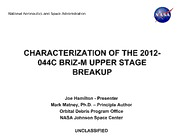
NASA Technical Reports Server (NTRS) 20130012734: Characterization of the 2012-044C Briz-M Upper Stage Breakup PDF
Preview NASA Technical Reports Server (NTRS) 20130012734: Characterization of the 2012-044C Briz-M Upper Stage Breakup
National Aeronautics and Space Administration CHARACTERIZATION OF THE 2012- 044C BRIZ-M UPPER STAGE BREAKUP Joe Hamilton - Presenter Mark Matney, Ph.D. – Principle Author Orbital Debris Program Office NASA Johnson Space Center UNCLASSIFIED 2 National Aeronautics and Space Administration Breakup Background • On 6 August, 2012, Russia launched two commercial satellites aboard a Proton rocket, and attempted to place them in geosynchronous orbit using a Briz-M upper stage (2012-044C, SSN 38746). • The upper stage failed early in its burn and was left stranded in an elliptical orbit with a perigee in low Earth orbit (LEO). • It broke up 16 October, creating a large cloud of debris with perigees below that of the International Space Station. • The NASA Orbital Debris Program Office requested radar assets to characterize the extent of the debris cloud in sizes smaller than the standard debris tracked by the SSN. 3 National Aeronautics and Space Administration Characterizing the Debris Cloud • The Space Surveillance Network (SSN) identifies the breakup and tracks the largest debris (> ~10 cm) • NASA uses staring radars to statistically sample the smaller debris population – Lincoln Laboratory’s HAX radar : > ~1 cm – Lincoln Laboratory’s Haystack radar : > ~ 5 mm • Not available due to upgrades – NASA’s Goldstone antenna : > ~ 2 mm • Limited availability due to use by Deep Space Network • Was unable to get low-altitude passes during available times 4 National Aeronautics and Space Administration NASA Breakup Model • In order to characterize an explosion, a breakup model needs to describe the initial cloud on the basis of: – Debris size distribution – Delta-velocity distribution – Ballistic coefficient distribution – Also would like to have information on shape and material type distribution, but these are much more difficult to obtain • NASA Breakup Model – Based primarily upon empirical data • Ground tests • Radar observations of on-orbit breakups – Represents “typical” breakup • Individual breakups can vary • Always in need of more data to validate/correct models 5 National Aeronautics and Space Administration NASA Breakup Model • NASA uses a Monte Carlo approach that generates a set of N “characteristic” fragments – Individual debris objects are “created” at known breakup time • Delta-velocity added to state vector of parent at time of breakup (provided by SSN) – Each orbit is propagated independently – If the model is accurate, the ensemble of debris should mimic the actual cloud • Separate models for explosion and collision • Can use the model in a “reference” mode – calculate what the model predicts and compare to actual data 6 National Aeronautics and Space Administration Anatomy of a Breakup • There are three phases of a breakup cloud: – The initial cloud, that is concentrated in space (Lasts hours to days) – The “ring” phase, where the debris mean anomalies are essentially randomized, but the cloud is still in an identifiable orbital plane (Lasts months to years) – The “background” phase, when the ascending nodes of the debris orbits become randomized • The time span of each phase is highly dependent on the parent orbit and where in the orbit that breakup occurred 7 National Aeronautics and Space Administration Evolution of BRIZ-M Breakup Cloud Based Upon Breakup Model Evolution • BRIZ-M mean anomaly is mostly randomized after a few days 8 National Aeronautics and Space Administration Beam Stare Strategy • Beam is parked at a particular elevation and azimuth • Rotation of the Earth causes beam to sweep across orbit arcs • While the orbit arc is in the beam, the rate of detection of a single object in that beam is once per orbit period • The detection probability for an object with a random mean anomaly in the given orbit will be: (cid:2157)(cid:2195)(cid:2197)(cid:2203)(cid:2196)(cid:2202) (cid:2197)(cid:2188) (cid:2202)(cid:2191)(cid:2195)(cid:2187) (cid:2197)(cid:2200)(cid:2184)(cid:2191)(cid:2202) (cid:2183)(cid:2200)(cid:2185) (cid:2191)(cid:2201) (cid:2191)(cid:2196) (cid:2184)(cid:2187)(cid:2183)(cid:2195) (cid:2172)(cid:2187)(cid:2200)(cid:2191)(cid:2197)(cid:2186) (cid:2197)(cid:2188) (cid:2197)(cid:2200)(cid:2184)(cid:2191)(cid:2202) • Assumptions only apply once debris mean anomalies are thoroughly randomized 9 National Aeronautics and Space Administration Stare Modes • Normally, NASA uses the Haystack and HAX radars in a 75° East mode (75° elevation, 90° azimuth) – Operating off-vertical provides indication of orbit inclination by using Doppler • However, because of the very low perigee of this breakup, much of cloud would pass too close to the HAX radar (closer than the nearest range bin) for some 75° elevation observations and times – Also, short-range observations can see smaller debris, but the count rate is lower because the beam is narrower at short ranges • NASA developed several optimal viewing modes based on the model predictions for this breakup cloud and asked for HAX to observe these modes – A variety of observation modes were run from day 293-301 10 National Aeronautics and Space Administration Probability Distribution
